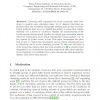Free Online Productivity Tools
i2Speak
i2Symbol
i2OCR
iTex2Img
iWeb2Print
iWeb2Shot
i2Type
iPdf2Split
iPdf2Merge
i2Bopomofo
i2Arabic
i2Style
i2Image
i2PDF
iLatex2Rtf
Sci2ools
EVOW
2005
Springer
2005
Springer
Order Preserving Clustering over Multiple Time Course Experiments
Abstract. Clustering still represents the most commonly used technique to analyze gene expression data—be it classical clustering approaches that aim at finding biologically relevant gene groups or biclustering methods that focus on identifying subset of genes that behave similarly over a subset of conditions. Usually, the measurements of different experiments are mixed together in a single gene expression matrix, where the information about which experiments belong together, e.g., in the context of a time course, is lost. This paper investigates the question of how to exploit the information about related experiments and to effectively use it in the clustering process. To this end, the idea of order preserving clusters that has been presented in [2] is extended and integrated in an evolutionary algorithm framework that allows simultaneous clustering over multiple time course experiments while keeping the distinct time series data separate. 1 Motivation A central goal in the analys...
Artificial Intelligence | Classical Clustering | EVOW 2005 | Gene Expression | Gene Expression Data—be |
Related Content
| Added | 27 Jun 2010 |
| Updated | 27 Jun 2010 |
| Type | Conference |
| Year | 2005 |
| Where | EVOW |
| Authors | Stefan Bleuler, Eckart Zitzler |
Comments (0)

